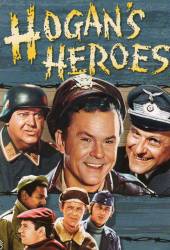Factual error: When the farmer sticks his pitchfork into the haystack, a scream is heard, but then everybody emerges unscathed. Wounds from pitchforks aren't like sitting on a brass tack - even a quick jab usually earns you a trip to the surgeon (I've seen such wounds), a vigorous stab like the one in the scene would go through limbs and could easily kill a man. There's no way anybody would walk away from such a hit.
Factual error: About 10 minutes into the show, Newkirk is using binoculars to watch Klink put the combination into his safe. He goes one direction for the first number, the opposite direction for the second number, then goes in the same direction for third number. Opposite for the fourth number. For the radial tumblers to set, it has to be alternating directions.
Factual error: In the rec hall where Klink is weightlifting, there is an advertisement poster for the Grindelwald region on the wall, which is in Switzerland. The German propaganda poured a lot of money into promoting the Reich's own recreational regions through the "Kraft durch Freude" program. With the war going badly, they especially wouldn't want a "Look how beautiful Switzerland is" poster in plain view of their troops every day.
Factual error: Burkhalter refers to Jesse Owens winning the gold medals in the Berlin Olympics, and that Hitler left the stadium every time Owens was to be presented a medal. Truth was, Hitler left the stadium when another black man won the day before, and didn't snub Owens at all. In fact, Hitler wasn't in attendance the days Owens won.
Six Lessons from Madame LaGrange - S5-E22
Factual error: Hilda is writing with her left hand. At the time of the Third Reich, it was still the practice in Germany to force left-handed children to learn to write with their right hand.
The Sergeant's Analyst - S5-E23
Factual error: In this episode, the running gag is that Schultz keeps flattening Col. Hogan's pumpernickel loaves. In reality, pumpernickel is a very compact bread that contains virtually no air at all and is impossible to flatten in this way. The shape is also wrong: pumpernickel is almost always baked in rectangular baking pans. To avoid confusion: the original, German pumpernickel is quite different from what's sometimes referred to as pumpernickel in England and America.
Factual error: As the staff car comes up the street, there are a number of neon signs lit up, as well as store fronts. This is wrong as during the night in wartime Europe, such lighting would be dark to avoid night bombing.
Factual error: Hogan calls the radio detection truck "radar" when he orders the SS guard to switch it off. From other episodes, we know that Hogan knows what radar is, and back then, the difference between radio homing equipment and radar was even clearer to people than it is today, because radio homing was an established technology, while radar was brand new, and most people were not even aware it existed.
Factual error: Baker picks up a lot of static in his radio, then suddenly signs off and says "Sounds like the radio detection unit picked up our signal." Unlike radar, radio signal homing relies entirely on measuring the signals emitted by the transmitter that is tracked. It works by comparing the strength of the signal arriving at each component of an array of directional antennae. The process is completely passive and does not cause any alteration of the signal measurable at either receiver or transmitter at all, and certainly not any audible interference or humming.
Factual error: Klink and Hogan sit behind each other in the P-51 they try to steal. The P-51 is a single-seat airplane, the only twin-seat P-51 are trainers. A trainer would not be at the flight line with the regular airplanes, and if a trainer would actually scramble with the others, it would at least arouse suspicion.
That's No Lady, That's My Spy - S6-E17
Factual error: Hogan tells Carter that the bush he's camouflaging himself with is poison ivy. Poison ivy is not native to Germany, the very few wild plants that exist today descend from those introduced to botanical parks after 1942.
Klink for the Defense - S6-E19
Factual error: About 8 minutes into show, Major Hochstetter asks Schultz how long Colonel Hogan (an American) has been running the camp, and Schultz says 3 years last November. This is impossible. The US didn't get into the war until December, 1941, He would have to have been captured November '42 or earlier but the war was over by November 1945.
Suggested correction: Not necessarily. Quite a few Americans served with the RAF before America declared war. The Eagle Squadron American volunteers fought at the Battle of Britain in 1940 for example.
The Kamikazes Are Coming - S6-E20
Factual error: When Hockstetter shows up in Klink's office he has two SS soldiers with him. One has a coat on with a general's rank insignia.
Factual error: Frankel suggests manipulating the missile's gyroscope, and Hogan suggests an electromagnet as means to do it, which is later implemented. Gyroscopes however are not affected by any magnetic force, which is what makes a gyroscopic compass superior to a magnetic one in many situations. To enhance that effect, gyroscopes are deliberately built out of materials with as little magnetic susceptibility as possible. A large electromagnet next to the missile could potentially cause all kinds of havoc with all kinds of parts of the missile guidance and control, but the gyroscope itself would not be among them.





